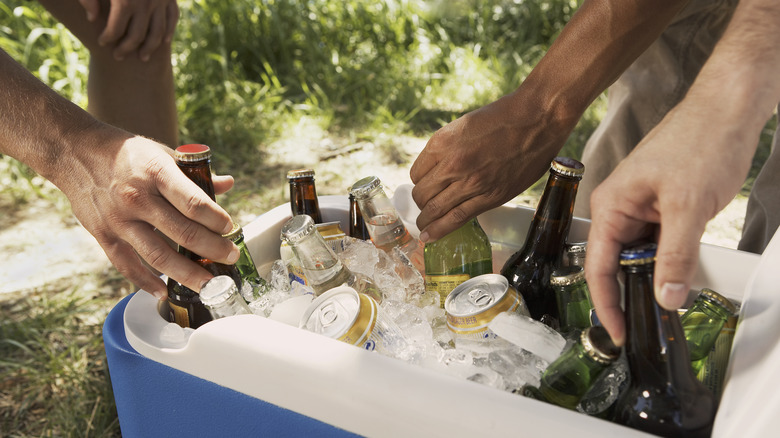How To Know What Temperature Beer Should Be Served At
Especially when sipped outdoors on a bright sunny day, few boozy beverages delight quite like a cold beer. Equal parts refreshing and flavorful, it's easy to understand how the brew's temperature is critical to enjoyment. Perhaps surprisingly, though, you won't want it icey cold.
As opposed to what our everyday vernacular suggests, those brews will taste better a few degrees warmer. The precise temperature varies widely, from around 38 to 60 degrees Fahrenheit, depending on the style. So, to sufficiently know the beer's serving temperature, you'll need to consider the brew contained inside.
It all has to do with how temperature impacts our taste sensations. As beers become warmer, the tongue becomes more attuned to a wider assortment of flavors. Once the temperature drops, the full palate becomes less discernible, often isolating only certain notes. However, take your beer too cold, and the brew also loses carbonation, affecting mouthfeel. Such factors explain why you shouldn't drink IPAs straight from the fridge, and why cellar-temperature cask ales have their own tap.
Consider the beer style for the optimal serving temperature
To some degree, there's no reason to fret over hitting the exact ideal temperature for each beer you want to enjoy. Just think about previous experiences you may have enjoyed. Even for the exact same beer, the serving temperature deviates based on the bar. Additionally, many craft beer establishments don't have temperature control for each tap. Throw in the subjective nature of individual taste, and hitting an exact number becomes less crucial to enjoyment.
Typically, the more alcoholic and complex the brew's palate, the higher the serving temperature. So, along with checking the label for occasional info, the ABV is the easiest indicator to check in a pinch. Macro lagers, which are typically the most popular beers, are ideal to serve at the coldest temperatures. These brews are built for drinkability and don't boast the most complex flavor profiles. They're perfect straight out of the fridge, so around 38 degrees Fahrenheit. Next coldest come the rest of the lager styles, since their clean, bottom fermentation style works better chilled. From 38 degrees up to 45 degrees Fahrenheit is ideal here.
From there emerge all the varying types of ales, including all the beloved styles of IPAs, which can go up to 50 degrees Fahrenheit. At that point, the liquid temperature warms up to 60 degrees for full-bodied stouts and barleywines. No matter which beer you enjoy, it's important to not serve it too cold or too warm.

